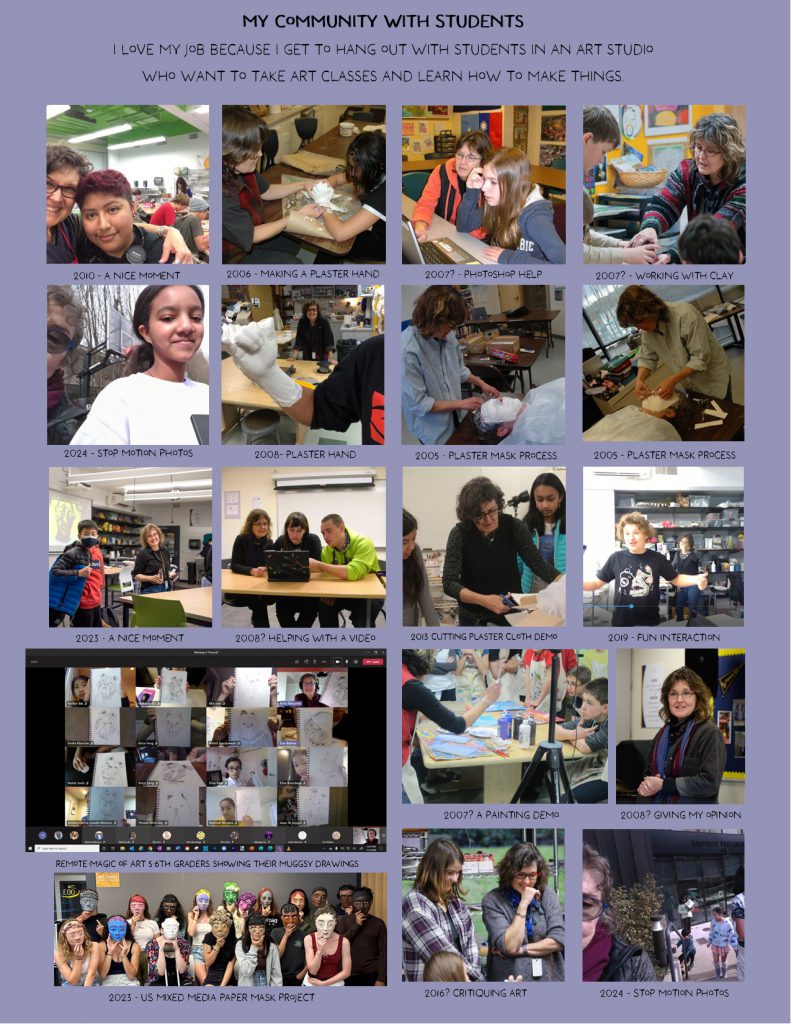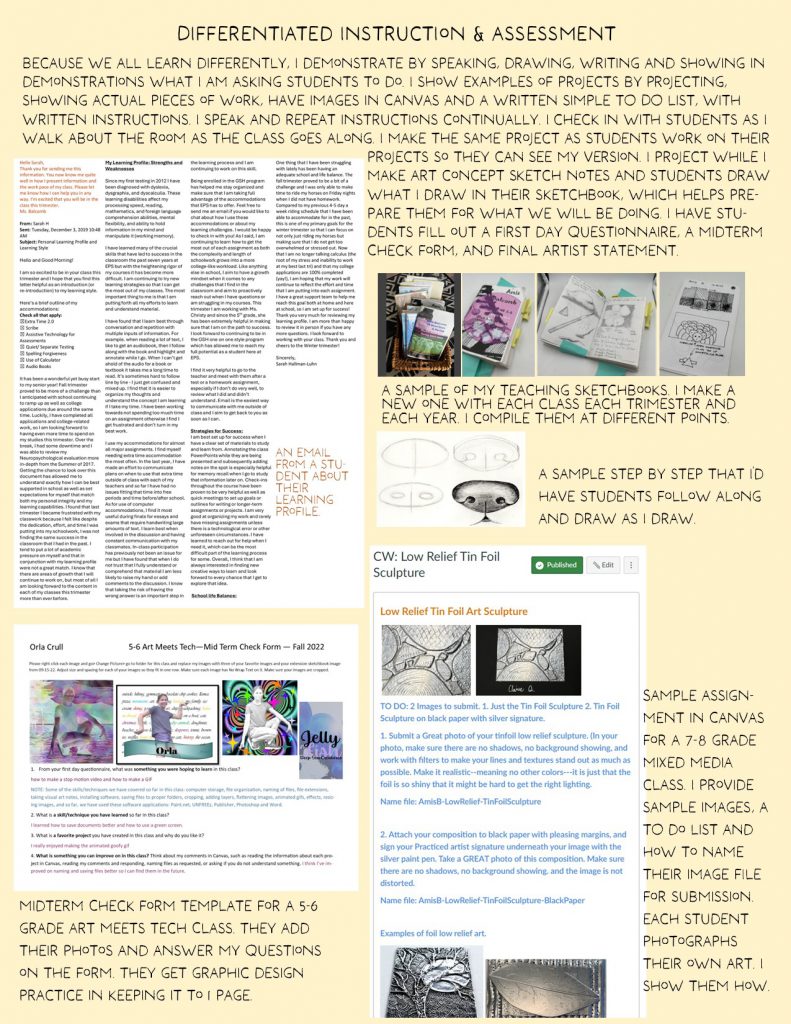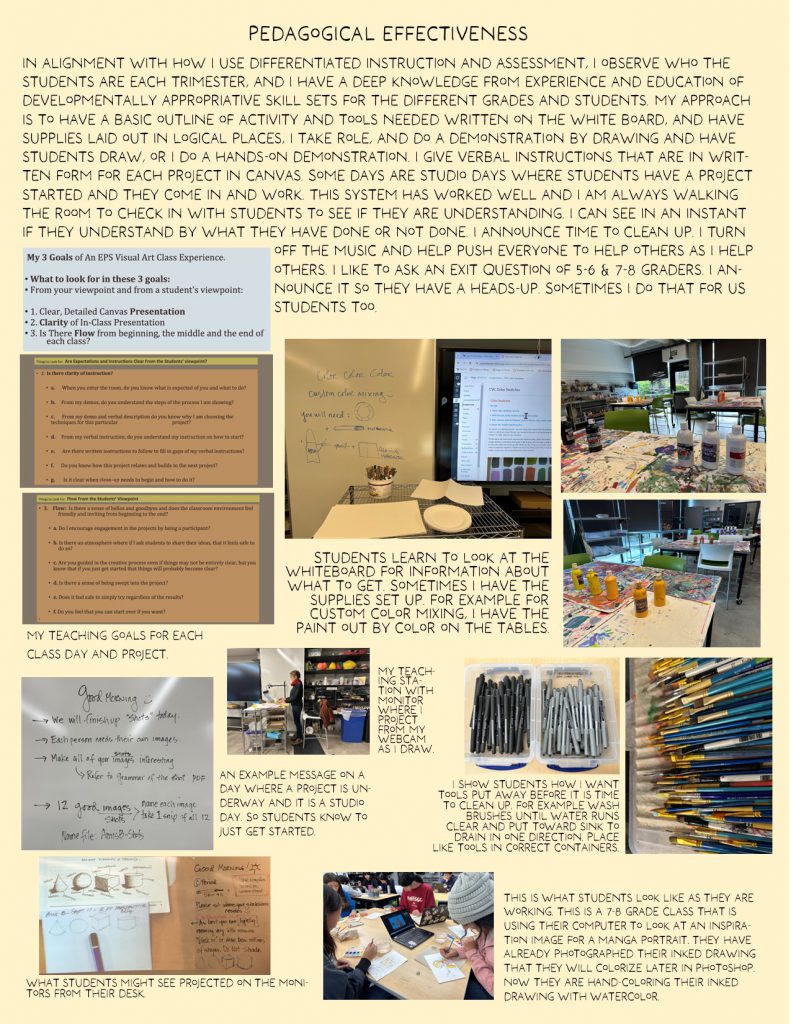Jump to: Classroom Culture | Differentiated Instruction and Assessment | Pedagogical Effectiveness
Classroom Culture
I’ve been teaching here for 19 years, and how do I do any one of these things? My main purpose and what drives me each day is to create a classroom culture where my students feel safe to learn how to make art, and that they are able to try out the projects regardless of a “successful” outcome. I find different ways to instill that it is in the process of doing the project where the skills develop.

Coaches and reinforces peer-to-peer dynamics that are appropriate and constructive.
- I share my expectations each class day, such as asking them to make eye contact with me when I call their name and I say hello or good morning, etc., while taking role. I accept a glance from those who find this difficult.
- I ask that students not talk while I am saying hello so I can hear everyone’s voice. I accept barely audible voices—acknowledging the effort made. I do not take this level of attendance every day but strive to do it several times a week. Most students accept and go along and some simply endure.
- I ring the singing bowl when I need to speak and wait until everyone catches on that the bell is ringing. I have to remember to do this. Sometimes I forget and start talking/screeching which never is good.
- I listen to how students talk to each other and intervene if I hear things that are not kind.
- I strive each day to interact with my students by greeting them when they come in and, most days, having an exit question as they leave. I’ve found that upper schoolers are not receptive to an exit question so I let them leave peacefully.
Communicates behavioral expectations that are appropriate to class activities.
- In every class, with every activity, I describe what students are to be doing and what they will be able to do by the end of class.
- I show where the brushes are and demo how to clean brushes.
- I often talk and walk the room and discuss art tool management for the best control and care of the tools. Tools that are cared for provide the best control and outcomes.
- I check in often as I walk the room in an informal way.
- I address noise volumes or socializing that is distracting as needed.
Develops a mutually respectful relationship with each student.
- In the process of making art together, we all get to know each other in a unique and nice way. It is a really cool window into each person’s world and allows me to ask questions about the color they chose, or the subject and how they arranged it on the page. In each class period and over the course of the trimester, I learn so much about them through how they work and what they do on their art projects.
- For example, when I observe them doing a project, I can get all positive and excited about their approach. Or I can guide them to get started by showing some examples if they are stuck. I encourage them to just try things out. And I always let them start over. But I will often encourage them not to and show them how cool their project looks and what the possibilities could be.
- I can witness how they work at a group table, if they are successful or not, and if not, I can move students around.
- I respect their art process and tell them that often as a group and individually. This builds trust and a bond.
- I often have the camera on my workstation and project, and do the same project as students so they can see my style and that I’m in the mix too.
Demonstrates cultural competence by promoting inclusivity.
- I strive to include diverse artists in my examples, and diversity in images of people represented in art.
- I use the pronouns he, she, they when I refer to people or describe others’ thinking.
- I am careful with my language of he, she, they pronouns and students’ names.
- Remembering student names is the most challenging. I need to study the yearbooks more often.
Designs and facilitates a classroom culture that promotes students’ preparedness, engagement, self-advocacy, perseverance, and collaboration.
- I show where things are.
- I demo by projecting how to start a project. I often adhere to the method of “I do-we do-you do” by having them sketch with me as I project my sketchbook. I like for students to practice techniques before starting a project.
- I write on the whiteboard what to get so that as students enter the room, they know to get set up. I have the necessary materials and tools on a center shelf near the whiteboard. Once the class is going, and if some things are not on the center shelf, students know where to go, such as cups for water or paper towels.
- I often discuss, as needed, the reason for listening to instructions. That everything I talk about is given for a reason, which is all about each student being successful with the project, and for taking good care of the tools.
- I give a demo/instruction at the beginning of each class.
- I daily encourage everyone to try to put forth their best effort daily. When I see misery, frustration, or defeat, in the face of my students, I always jump in and give my opinion “Hey, I think this turned out well.” That, “Sometimes it is good to get away from the project and have fresh eyes on it another day.” And sometimes I say, “Not everything turns out the way we want. And tossing something is a legitimate thing that artists sometimes do.”
- I provide what I call “Studio Time” that I write on the whiteboard, and everyone loves to see this. Everyone loves to just work. This occurs when we are doing a project that is off and running into a second or third class day. The upper school classes get longer projects with more allotted studio days.
Differentiated Instruction and Assessment
Considers and addresses each student’s learning profile
- I review my class rosters before the trimester starts to reflect on who I have taught before and to see who all is new to my classes.
- I observe the class as they enter the room, where they sit and with whom.
- I look at the Details in Canvas if I suspect a student is struggling or not understanding. I often choose not to look at the Details in Canvas so I can see each student with unbiased eyes. But this may not be a good practice. This is something I should ask colleagues/ guided study hall counselors about.

Designs class activities and assignments that engage and accommodate both individual students and a diverse group of learners.
- All of my projects/assignments are time-tested over the years for the grades I am presenting to. This gets reinforced when I review student samples of each project to see exactly what that age group is capable of doing. I often adjust my expectations for the class based on the first few exercises and projects.
- I start out with a list and put them in the order I feel like doing them.
- In each past trimester, I can see what projects we actually got to do.
- This varies and depends on who the students are in the class and the pace.
- It also depends on the length of the trimester and if we have school weather closures.
Builds in opportunities for each student to contribute during each class period.
- Each student participates in each class by simply following instructions and trying out the projects.
- I read the room and ask the room questions and see who responds.
- I circulate and individually ask students what their thoughts are on a particular topic or if they have questions if they seem to be stuck.
Pedagogical Effectiveness

Begins class sessions with a clear statement about the lesson’s objectives and place in the progression of the course
- White board instruction with materials out that we will use that day.
- I speak about the project and the technique and the skills it builds. Why we are using the brush, paper, etc we are using.
Designs and implements varied activities in each class period
- This is my goal by teaching in an emergent fashion. The “I do-we do-you do” method works well for most projects.
- I strive for student choice in most projects within the general art concepts presented, and a specific method. Such as using only two colors to start, or dry brush technique, or watercolor washes versus full saturated opaque color. I always explain why and show examples. On occasion I will have a student who just wants to do things their way. I’ll end up letting them but I will have a conversation about trying new things for specific reasons. I usually win them over at some point in the trimester when they can see other student’s work.
Brings each activity to closure effectively and transitions intentionally to subsequent activities
- I try. I assign/ask for a student to help me track time. I try to have an exit question for all 5-6 graders who love and ask for them, and most 7-8 classes, who some like it and some are bothered. Once in a while I’ll force an upper school class to endure an exit question.
- Closing a class on time and allowing for a proper clean-up is the challenge each day. I’m getting better at it.
Ensures that students are using technological tools effectively
- I take time and build into each project how and why I ask students to use technology such as in taking good photos of all of their artwork, and sometimes in using their images to create new digital images, in completing a mid-term comment form, PowerPoint files for monitor display and a digital portfolio. My Art Meets Tech and Digital Story Telling classes are 90% all digital. In both of these classes I have them go old school by sometimes taking visual notes in a sketchbook. I project and write/draw in my sketchbook and they draw with me. Sometimes I have a directive on the white board for them to draw/write something on their own.
Concludes class with a summary and clear tie-in to the next class
- I strive to describe in words and in my demos how what we do in class today leads into what we will do in our next class. For example how curving lines and shading make flat shapes into 3D forms.